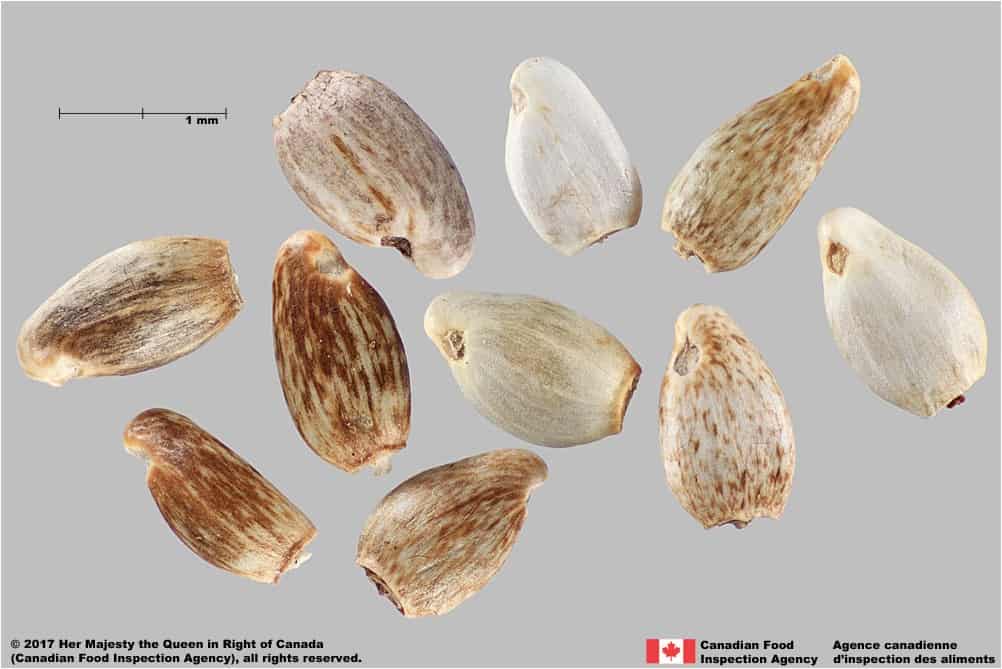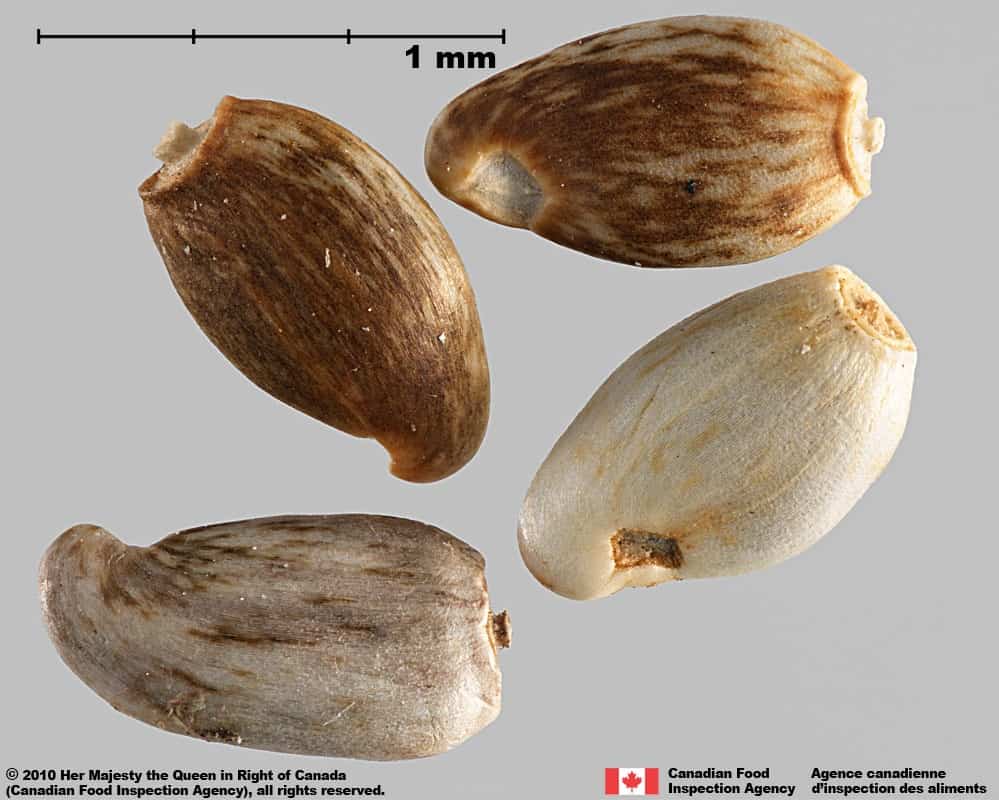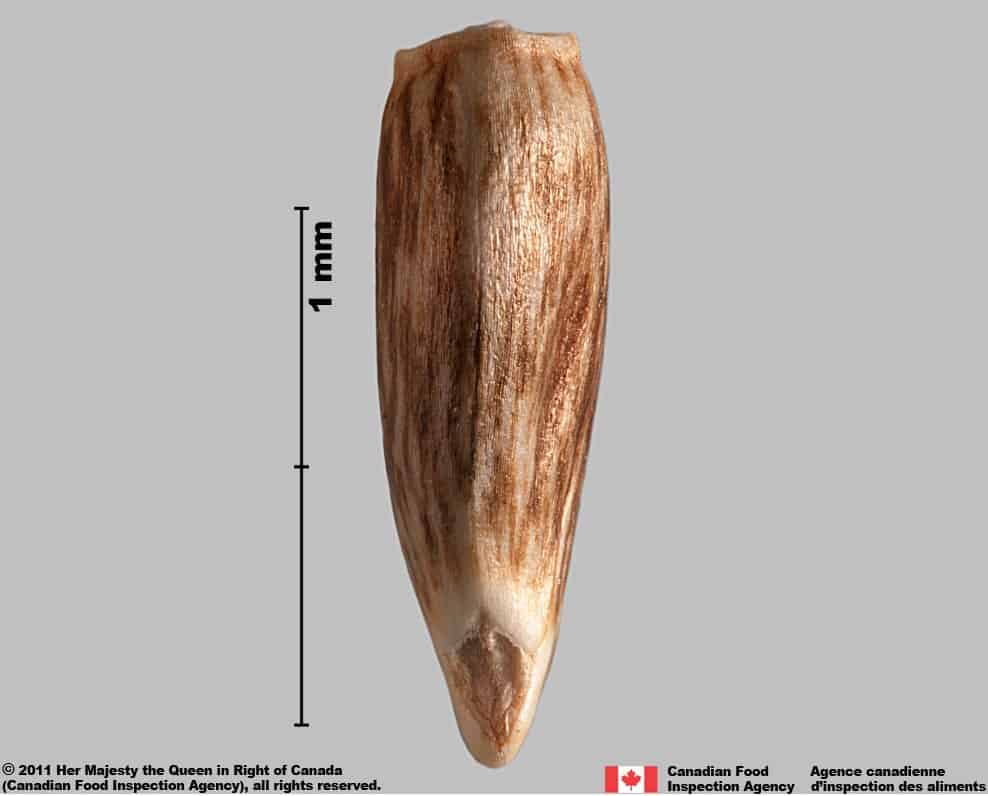Centaurea iberica
Overview
Aperçu
Regulation :
Remarques Réglementation:
- CFIA Weed Seeds Order - Class 1: Prohibited Noxious Weed Seeds
- List of Pests Regulated by Canada
Regulation Notes:
Prohibited Noxious, Class 1 in the Canadian Weed Seeds Order (2016) under the Seeds Act. All imported and domestic seed must be free of Prohibited Noxious weed seeds.
Distribution :
Répartition :
Native to Asia and Europe (USDA-ARS 2020). Introduced in the United States (California, Kansas, Oregon, Washington, Wyoming) (CABI 2020; USDA-ARS 2020). Also introduced in Argentina and outside of its native range in Europe (CABI 2020; USDA-ARS 2020). Absent from Canada (Brouillet et al. 2010+).
Habitat and Crop Association :
Habitat et Cultures Associées :
Fields, pastures, rangelands, woodlands, shrub lands, banks of watercourses, roadsides and disturbed areas (DiTomaso and Healy 2007; CABI 2020). In the United States, it is highly competitive along roadsides and in rangelands (ODA Undated).
Economic Use, cultivation area, and Weed Association :
Utilisation économique, zone de culture et association de mauvaises herbes :
Duration of Life Cycle :
Durée du cycle vital:
Biennial, annual or perennial
Dispersal Unit Type :
Type d’unité de dispersion :
Achene
General Information
RENSEIGNEMENTS GÉNÉRAUX
Centaurea iberica was accidently introduced into the western United States, from where it has since spread, most notably in the 1920s (DiTomaso and Healy 2007) and the 1950s (Graham and Johnson 2003).
.Identification
Identification
-
Achene
Size
- Achene length*: 3.2 – 4.0 mm; width: 1.3 – 2.1 mm
*Note: minimum and maximum of 10 achenes in a normal range of this species using image measurement (ISMA 2020)
Shape
- Oblong shaped achene with a narrow rounded notched end and a wider truncate end, laterally compressed
Surface Texture
- Achene is smooth
Colour
- Achene is generally shiny white with brown streaks, but can be solid white coloured
Other Features
Pappus
- Pappus length: 1.0 – 2.5 mm (FNA 1993+)
- White pappus is composed of flat bristles of variable lengths in several rings. Outer pappus bristles are the shortest, increasing in length towards the inside, the innermost bristles cover the style remnant
Achene end with pappus
- A small style remnant is present in the center of the truncate end
Achene end without pappus
- The notch at the narrow end is generally shallow but long relative to the achene size, making the rounded end look narrow
- The surface is glossy light yellow-coloured around side notch

Iberian starthistle (Centaurea iberica) achenes




-
Seed
Size
- Seed size similar to achene size
Shape
- Seed is oblong shaped
Surface Texture
- Seed surface is smooth
Colour
- Seed is orange or yellow coloured
Other Features
- Seed coat brown, adhering to fruit wall
-
Embryo
Size
- The embryo fills the seed
Shape
- Embryo is spatulate, axial position
Endosperm
- Endosperm absent, nutritive tissue stored in the cotyledons
Other Features
- Cotyledons are fleshy and soft-textured
Identification Tips
CONSEILS POUR L’IDENTIFICATION
The combination of a shining brown streaked pattern is distinctive, along with a light yellow side notch and persistent pappus.
Additional Botany Information
AUTRES RENSEIGNEMENTS BOTANIQUES
Flowers/Inflorescence
- Flower heads oval shaped, flowers white, pink or purple (FNA 1993+)
Vegetative Features
- Involucral bracts are broad oval shaped, tipped with a long, straw yellow spine and smaller spines near the base
Similar Species
ESPÈCES SEMBLABLES
Similar species are based on a study of seed morphology of various species, and those with similar dispersal units are identified. The study is limited by physical specimen and literature availability at the time of examination, and possibly impacted by the subjectivity of the authors based on their knowledge and experience. Providing similar species information for seed identification is to make users aware of similarities that could possibly result in misidentification.
Centaurea calcitrapa L. (purple starthistle)
The achenes of C. calcitrapa are generally smaller (length*: 2.4 – 3.0 mm), have a smaller side notch, generally dull reddish-brown streaked pattern and lack a pappus compared to C. iberica.
*Note: minimum and maximum of 10 achenes in a normal range of this species using image measurement (ISMA 2020)
Click to select species
Cliquez pour sélectionner les espèces

Centaurea calcitrapa
Comparison Window
Fenêtre de comparaison
MAIN SPECIES
ESPÈCES PRINCIPALES
Centaurea iberica

Centaurea iberica
Asteraceae
Iberian starthistle (Centaurea iberica) achenes
MAIN SPECIES
ESPÈCES PRINCIPALES
Centaurea iberica

Centaurea iberica
Asteraceae
Iberian starthistle (Centaurea iberica) achene, side view
MAIN SPECIES
ESPÈCES PRINCIPALES
Centaurea iberica

Centaurea iberica
Asteraceae
Iberian starthistle (Centaurea iberica) achene, top-down view
MAIN SPECIES
ESPÈCES PRINCIPALES
Centaurea iberica

Centaurea iberica
Asteraceae
Iberian starthistle (Centaurea iberica) achene, basal notch
SIMILAR SPECIES
ESPÈCES SEMBLABLES
Centaurea calcitrapa

Centaurea calcitrapa
Asteraceae
Purple starthistle (Centaurea calcitrapa) achenes
SIMILAR SPECIES
ESPÈCES SEMBLABLES
Centaurea calcitrapa

Centaurea calcitrapa
Asteraceae
Purple starthistle (Centaurea calcitrapa) achenes
SIMILAR SPECIES
ESPÈCES SEMBLABLES
Centaurea calcitrapa

Centaurea calcitrapa
Asteraceae
Purple starthistle (Centaurea calcitrapa) achene; side view
SIMILAR SPECIES
ESPÈCES SEMBLABLES
Centaurea calcitrapa

Centaurea calcitrapa
Asteraceae
Purple starthistle (Centaurea calcitrapa) achene
Need ID Help?
Besoin d’aide pour l’identification?
Reference(s)
Référence(s)
Brouillet, L., Coursol, F., Meades, S. J., Favreau, M., Anions, M., Bélisle, P. and Desmet, P. 2010+. VASCAN, the database of vascular plants of Canada. http://data.canadensys.net/vascan/ Accessed October 15, 2020.
Centre for Agriculture and Bioscience International (CABI). 2020. Invasive Species Compendium, CAB International, Wallingford UK. https://www.cabidigitallibrary.org/journal/cabicompendium Accessed October 8, 2020.
DiTomaso, J. M. and Healy, E. A. 2007. Weeds of California and Other Western States. Vol. 1. 834 pp. University of California, CA.
Flora of North America (FNA) Editorial Committee, eds. 1993+. Flora of North America North of Mexico [Online]. 22+ vols. New York and Oxford. http://beta.floranorthamerica.org. Accessed December 29, 2022.
Global Biodiversity Information Facility (GBIF) Secretariat. 2022. https://doi.org/10.15468/39omei Accessed via https://www.gbif.org/species/3129000 Accessed December 29, 2022.
Government of Canada (GC). 2016. Canadian Weed Seeds Order. https://laws-lois.justice.gc.ca/eng/regulations/SOR-2016-93/page-2.html (English) https://laws-lois.justice.gc.ca/fra/reglements/DORS-2016-93/page-2.html (French)
Graham, J. and Johnson, W. S. 2003. Managing Purple and Iberian Starthistles, www.unce.unr.edu/publications/files/nr/2003/FS0346.pdf Accessed May 30, 2016.
Integrated Taxonomic Information System (ITIS). 2020. https://www.itis.gov/ Accessed June30, 2020.
International Seed Morphology Association (ISMA). 2020. Method for Seed Size Measurement. Version 1.0. ISMA Publication Guide. https://www.idseed.org/authors/details/method_for_seed_size_measurement.html
Oregon Department of Agriculture (ODA). 2020. Oregon Noxious Weed Profiles. Iberian starthistle Centaurea iberica, https://www.oregon.gov/oda/shared/Documents/Publications/Weeds/IberianStarthistleProfile.pdf Accessed October 8, 2020.
Plants of the World Online (POWO). 2020. Facilitated by the Royal Botanic Gardens, Kew. Published on the Internet; http://www.plantsoftheworldonline.org/ Accessed October 8, 2020.
U.S. Department of Agriculture-Agricultural Research Services (USDA-ARS). 2020. Germplasm Resources Information Network (GRIN), https://npgsweb.ars-grin.gov/gringlobal/taxon/taxonomysimple.aspx Accessed October 15, 2020.




